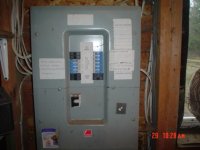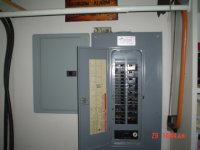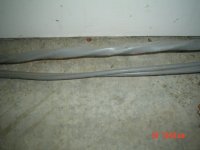On mine I added a second breaker at my meter box and wired my shed for 200 amp , 220v service. I ran 125 ft of 4/4/2 wire I bought at menards. At the time, it was about a buck a foot and I dug the trench myself. Phone and water consideration is something worth thinking about if you are having to dig a trench, less work later. Wish I would have.
You are using an out of date browser. It may not display this or other websites correctly.
You should upgrade or use an alternative browser.
You should upgrade or use an alternative browser.
How far is too far??
- Thread starter RxRatedZ71
- Start date
/ How far is too far??
#11
smfcpacfp
Veteran Member
- Joined
- Nov 21, 2007
- Messages
- 1,346
- Tractor
- Kubota B3030HSDC
I thought I had mentioned it earlier, but I am looking to avoid having the power company come back out and run "primary" to the shop. When we built our house, we planned to "feed" the shop out of our house's meter & panel. Thus making the shop run on "secondary". I learned that if the Electric Co-Op were to come out, they would love to run power from the transformer to the shop. However, they also want a monthly fee for another meter, and then your electric bill increases by at least $30/month just b/c of accessibility.
I wasn't suggesting a second meter, necessarily, but it isn't the distance from the house to the pole building that is important, it is the distance from the power company transformer to where the power will be used that will determine the voltage loss. By the way, my second meter has run about $10 a month.
Given the varied and contradictory information provided by other posters whose credentials you know nothing about, I go back to my original suggestion which would be to contact your local power company to see what they say. I doubt they would charge you to come out and look at your situation.
Mousefield
Elite Member
- Joined
- Aug 24, 2008
- Messages
- 2,585
- Tractor
- Sold 2008 CK35 HST
I put in a separate panel when I built my barn about 9 years ago. It runs off one 15 amp breaker from my main house panel. From panel to panel it is about 200 ft. Can't remember the wire size but in the wire pic it is the larger one and has smaller wire twisted inside. The barn panel has a number of breakers, this is to minimize the load on any one circuit and easier for me to work on if there is a problem. Did all the wiring and installed panel in barn myself. I never intended to use large amount of juice in the barn, lights and light power tools. I just built another goat pen in the barn and used skill saw, belt sander and lights and had no issues. Don't think I ever had a breaker trip yet. I also have a land line phone and security wire in the barn. Phone is nice as we do get bear close to the barn and if needed we can call for help. Also ran a water line from the house to the barn, have a laundry sink for washing up.
Pic #1 is barn panel. Pic #2 is house panel; barn breaker on top right, smaller panel on left is our generator panel. Pic #3 larger wire on top is the wire to barn, the smaller wire is to outside barn lights we can switch on from the house before going to the barn at night.
Pic #1 is barn panel. Pic #2 is house panel; barn breaker on top right, smaller panel on left is our generator panel. Pic #3 larger wire on top is the wire to barn, the smaller wire is to outside barn lights we can switch on from the house before going to the barn at night.
Attachments
okclumberjack
Member
- Joined
- Apr 5, 2010
- Messages
- 39
hey neibour live ne 63 & coltrane have seperate service for my shop didnt
cost any thing up front but the rates is higher then my house, i have 240 volt 200 amp svc.
cost any thing up front but the rates is higher then my house, i have 240 volt 200 amp svc.
DTCOOPER
Bronze Member
On mine I added a second breaker at my meter box and wired my shed for 200 amp , 220v service. I ran 125 ft of 4/4/2 wire I bought at menards. At the time, it was about a buck a foot and I dug the trench myself. Phone and water consideration is something worth thinking about if you are having to dig a trench, less work later. Wish I would have.
I certainly hope you are not protecting 4awg with a 200 amp breaker... If so, your wire is the fuse. And in an overcurrent situation, the wire is what will "trip".... Maybe you made a typo ?
Gale Hawkins
Super Star Member
- Joined
- Sep 20, 2009
- Messages
- 11,946
- Location
- Murray, KY
- Tractor
- 1948 Allis Chambers Model B 1976 265 MF / 1983 JD 310B Backhoe / 1966 Ford 3000 Diesel / 1980 3600 Diesel
I certainly hope you are not protecting 4awg with a 200 amp breaker... If so, your wire is the fuse. And in an overcurrent situation, the wire is what will "trip".... Maybe you made a typo ?
He just fed 200 amp service box from his house is sounds like to me but he did not say what amp he used on rereading the post.
Obed
Elite Member
RxRatedZ71,Just run the wire size calculation
300ft is no problem you have to use the calculator and up size the wire to cut the voltage drop.
Here is one that I like
Wire Size Calculator
tom
I used the Wire Size Calculator that Tom gave the link to.
Load Calculation
Overhead lights 15 A
Refrigerator circuit 15 A
Space heater circuit 15 A
Circuit for other outlet 15 A.
Total: 60 A at 120V
Solution
You could run a 240 V line (3 conductors plus ground) to your barn from a 30 A 240V breaker in your house panel. The 240V line will actually provide you two 120V lines at 30 A each for a total of 60 A at 120V which is what you need. Put the refrigerator circuit and space heater circuits on opposite 120V legs of the 240V wire to balance your load and to minimize voltage drop. Using the online wire calculator:
120V, 30A, copper, single phase, 265'
Wire Size
You need a #2 size copper line between the house and your barn and you will be fine. If you go with a smaller wire, you will have voltage drop problems at the barn which will cause problems and could damage your equipment (especially the compressor used by the refrigerator). This design does not require an extra meter as you requested. However, doing it this way will have an up-front cost of paying for the large #2 wire.
If you were willing to pay for the extra power company meter at the barn, then you could run a much smaller wire (less cost) to the barn because you would be running a high voltage line which would be stepped down to 240V/120V using a transformer close to the barn.
Note: I have an electrical engineering degree but am not a licensed electrician so get a professional opinion before proceeding.
Good luck with your project,
Obed
hr3
Veteran Member
Rx. I have about the same uses as you are going to use in your new barn as I do now, and the same distances you are dealing with.. This is what I did and it works fine. Starting at my MDP "main panel" Feed breaker size 70amp. #2 alum. SER.. wire from the breaker to a pvc junction box in the basement where the wire is to go outside. Pipe out the back of the box to an 1-1/2 pvc lb on the outside of the building.. 1 1/2 pvc conduit.. "electrical conduit" to the barn and up into your main breaker in your new barn panel use #2 urd 4 wire in the conduit.
I also ran a black and white #10 copper to the barn for my block heater.. That way a half hour before I go out to plow snow I can turn it and an outside light on before I go out.
I also ran a black and white #10 copper to the barn for my block heater.. That way a half hour before I go out to plow snow I can turn it and an outside light on before I go out.
biggerten
Gold Member
I'm not a licensed electrician, either. But, as Obed says, I know you do need to run both a ground and a neutral as well as your 'hot' conductors. And go bigger than you think you need, you will be out a few extra dollars now, but in the end will never regret it.
JonKioti
Silver Member
Are you confused yet?
You need to figure out your load first. Lights plus power tools plus heater, etc. Will there be a compressor kicking in when you have the heater on? These numbers need to be added together to get total possible load.
Lights don't take much but everything will have a current rating in amps. The compressor might draw a bit more on startup than the running current. This type of information is sometimes difficult to find, so the general rule is to add a fudge factor of about 50%.
If, for example, you load came to 20 amps, select a cable that would handle 30 amps for the distance you will need to go. When you pick up your cable, see if the cost to go to the next size up is feasible, i.e. a number #8 cable is not likely much more expensive than a #10.
I would bury the cable in 2" PVC conduit with 90 degree radius bends on each end to bring the cable up out of the ground. An LB bend (it's a sharp 90 bend with an access plate) is used to then turn the cable and go through the wall of the house and another into the barn.
Use PVC cement (works like ABS cement) for all joins and you shouldn't have a problem with water infiltration. 2" PVC is costing me $2.33 a foot, the bends are around $12 each. That would total about $665.00 in conduit but will last forever, especially if you bury it in sand or at least ensure there are no rocks likely to come in contact with it.
I would also suggest burying a second pipe (a low cost poly pipe will work) for phone line, and a length of PEX pipe if you want water out there. Again, larger diameter will work better in the long run.
I would also suggest tracking down some weatherproof T-5 florescent fixtures. These use the newer, thin 4' bulbs which take less power than incandescent and produce more light than CFLs.
Good luck!
Jon
You need to figure out your load first. Lights plus power tools plus heater, etc. Will there be a compressor kicking in when you have the heater on? These numbers need to be added together to get total possible load.
Lights don't take much but everything will have a current rating in amps. The compressor might draw a bit more on startup than the running current. This type of information is sometimes difficult to find, so the general rule is to add a fudge factor of about 50%.
If, for example, you load came to 20 amps, select a cable that would handle 30 amps for the distance you will need to go. When you pick up your cable, see if the cost to go to the next size up is feasible, i.e. a number #8 cable is not likely much more expensive than a #10.
I would bury the cable in 2" PVC conduit with 90 degree radius bends on each end to bring the cable up out of the ground. An LB bend (it's a sharp 90 bend with an access plate) is used to then turn the cable and go through the wall of the house and another into the barn.
Use PVC cement (works like ABS cement) for all joins and you shouldn't have a problem with water infiltration. 2" PVC is costing me $2.33 a foot, the bends are around $12 each. That would total about $665.00 in conduit but will last forever, especially if you bury it in sand or at least ensure there are no rocks likely to come in contact with it.
I would also suggest burying a second pipe (a low cost poly pipe will work) for phone line, and a length of PEX pipe if you want water out there. Again, larger diameter will work better in the long run.
I would also suggest tracking down some weatherproof T-5 florescent fixtures. These use the newer, thin 4' bulbs which take less power than incandescent and produce more light than CFLs.
Good luck!
Jon


